Bhishma Karki 1, Saddam Husain Dhobi 2, 3, 4, Kishori Yadav 2, Narayan Gautam 1
1Department of Physics, Tri-Chandra Multiple Campus, Tribhuvan University, Kathmandu, Nepal
2Department of Physics, Patan Multiple Campus, Tribhuvan University, Lalitpur, Nepal
3Robotics Academy of Nepal, Lalitpur, Nepal
4Innovative Ghar Nepal, Lalitpur, Nepal
Correspondence to: Bhishma Karki , Department of Physics, Tri-Chandra Multiple Campus, Tribhuvan University, Kathmandu, Nepal.
| Email: |  |
Copyright © 2021 The Author(s). Published by Scientific & Academic Publishing.
This work is licensed under the Creative Commons Attribution International License (CC BY).
http://creativecommons.org/licenses/by/4.0/

Abstract
The strength of linear combined short-range potential (Yukawa plus Hulthen) is calculated using two different centrifugal term approximation (equation 2 and equation 3). The calculation shows that the strength of potential calculated using an approximation of equation (3) is greater than equation (2), but the difference between them is negligible. Therefore, both approximation is used to calculate the energy eigenvalue of considering a potential system. Besides also, the functional value goes decreasing with increasing screening parameters and nucleon separation distance. This decreasing functional value shows the nature of potential Yukawa plus Hulthen potential is short-range potential.
Keywords:
Yukawa plus Hulthen Potential, Centrifugal term, Functional Value, Strength, etc
Cite this paper: Bhishma Karki , Saddam Husain Dhobi , Kishori Yadav , Narayan Gautam , Effect of Centrifugal Term Approximation on Short Range Potential, International Journal of Theoretical and Mathematical Physics, Vol. 11 No. 2, 2021, pp. 71-76. doi: 10.5923/j.ijtmp.20211102.03.
1. Introduction
Yukawa potential is applicable in various fields of physics like high energy physics, atomic, molecular, plasma physics etc. Yahya et al calculated the energy level of neutral atoms using Yukawa potential. Similarly, Hulthen potential is also applicable in various filed like nuclear and high-energy physics, atomic physics, solid-state physics, chemical physics, relativistic and non-relativistic quantum mechanics etc. These both potential are short ranges [1] and in general Hulthen like the potential is defined as,  | (1) |
Here,  value defines a specific potential like for
value defines a specific potential like for  potential is exponential type, for
potential is exponential type, for  potential is Hulthen potential, for
potential is Hulthen potential, for  potential is Woods-Saxon potential and so on. This generalization is structured by Egrifes et al. in 1999. In tensor form, Hulthen and Coulomb like the potential is defined as
potential is Woods-Saxon potential and so on. This generalization is structured by Egrifes et al. in 1999. In tensor form, Hulthen and Coulomb like the potential is defined as  Here
Here  is potential depth,
is potential depth,  is screening parameter, and 𝑏 is spatial range. In an atomic unit, one can define
is screening parameter, and 𝑏 is spatial range. In an atomic unit, one can define  Equation (1) behaves like the Coulomb potential at
Equation (1) behaves like the Coulomb potential at  and decreases exponentially in case 𝑟≫0. Hulthen potential is widely used for the description of the nucleon-heavy nucleus interactions [2]. For analytical approximate solutions for short ranges potential an approximation for the centrifugal term is used [3] as,
and decreases exponentially in case 𝑟≫0. Hulthen potential is widely used for the description of the nucleon-heavy nucleus interactions [2]. For analytical approximate solutions for short ranges potential an approximation for the centrifugal term is used [3] as, | (2) |
This approximation is valid for small values of screening parameter  . The value of screening parameters used to solve the energy eigenvalue is used in ranges from
. The value of screening parameters used to solve the energy eigenvalue is used in ranges from  to
to  Also, potential depth is selected in this work is selected as
Also, potential depth is selected in this work is selected as  [4] in rages 0 to
[4] in rages 0 to  The wave number-dependent scattering phase shifts
The wave number-dependent scattering phase shifts  for a Hulthén type potential plus Yukawa potential in atomic units
for a Hulthén type potential plus Yukawa potential in atomic units  for 𝑙 = 0 &
for 𝑙 = 0 &  [5,6]. Also, for analytical approximate solutions of short ranges potential an approximation for the centrifugal term is used by different authors (Qiang and Dong, 2007; Dong and Gu, 2008; Jia et al., 2009, Greene and Aldrich, 1976) as,
[5,6]. Also, for analytical approximate solutions of short ranges potential an approximation for the centrifugal term is used by different authors (Qiang and Dong, 2007; Dong and Gu, 2008; Jia et al., 2009, Greene and Aldrich, 1976) as, | (3) |
This centrifugal term approximation is also valid for small screening parameters that δ << 1. Yukawa potential is defined [7] as  Here k is the strength of the interaction,
Here k is the strength of the interaction,  is a range of the interaction, r is the separation distance between nucleons. In the case of
is a range of the interaction, r is the separation distance between nucleons. In the case of  Yukawa potential tends to Coulomb potential and infinite bound state while in the case of
Yukawa potential tends to Coulomb potential and infinite bound state while in the case of  the Yukawa potential has a finite bound state [8,9,10].
the Yukawa potential has a finite bound state [8,9,10].
2. Method and Material
Okon et al. reported the bound state solutions of the Schrödinger equation with the Hulthén-Yukawa plus inversely quadratic potential. Yukawa potential is an effective potential to describe the strong interaction between nucleons. Both potentials behave coulombic potential at a small distance  and go down exponentially for larger
and go down exponentially for larger  . The linear combination of Hulthén and Yukawa potentials studies in this work. Moreover, some authors are work on energy eigenvalue using the KG equation (Garavelli and Oliveire, 1991; Mathysand and Meyer, 1988; Blokhintesv et al., 2011) [11]. The linear combination of these two potential (Yukawa and Hulthen potential) areas
. The linear combination of Hulthén and Yukawa potentials studies in this work. Moreover, some authors are work on energy eigenvalue using the KG equation (Garavelli and Oliveire, 1991; Mathysand and Meyer, 1988; Blokhintesv et al., 2011) [11]. The linear combination of these two potential (Yukawa and Hulthen potential) areas | (4) |
To study the strength of potential here authors used the linear combination with centrifugal term approximation  , therefore equation (4) becomes
, therefore equation (4) becomes | (5) |
 | (6) |
Table 1. Function value of z with variables r and δ
 |
| |
|
Table 2. Yukawa Plus Hulthen Potential with centrifugal term approximation based on equation (2)
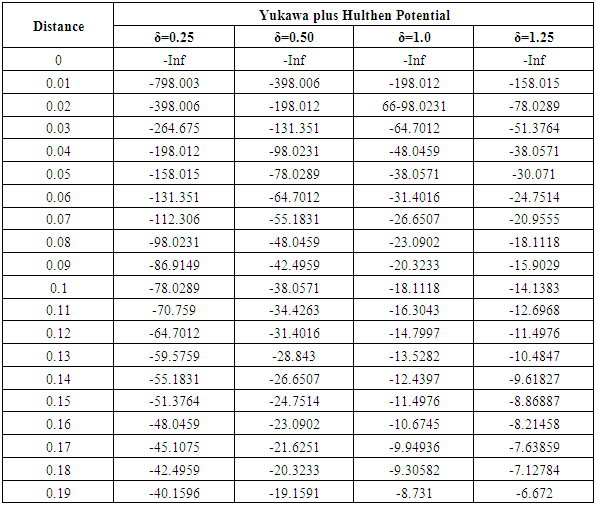 |
| |
|
Table 3. Yukawa Plus Hulthen Potential with centrifugal term approximation based on equation (3)
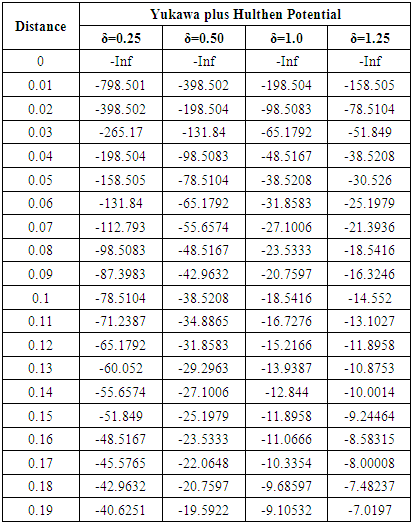 |
| |
|
This is the combined form of Yukawa potential and Hulthen potential, let  therefore from equation (6), one can write,
therefore from equation (6), one can write,  | (7) |
The tabulated functional values are listed in table 1, for different screening parameters and nucleon separation. The numerical value of equation (7) using a centrifugal term approximation of equation (2) are calculated using Matlab and tabulated in table 2. The tabulated value is Yukawa plus Hulthen potential at different screening parameters with distance. Tabulated value shows with an increase in the distance the strength of Yukawa plus Hulthen potential is decrease.Also from equation (4) on using centrifugal term approximation from equation (3) the strength of Yukawa plus Hulthen Potential is obtained as,  | (8) |
On arranging and substituting  equation (8) becomes,
equation (8) becomes, 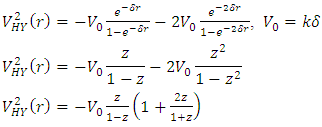 | (9) |
This is the combined form of Yukawa potential and Hulthen potential, therefore we have The numerical value of equation (9) using a centrifugal term approximation of equation (3) are calculated using Matlab and tabulated in table 3. The tabulated value is Yukawa plus Hulthen potential at different screening parameters with distance. Tabulated value shows with an increase in the distance the strength of Yukawa plus Hulthen potential is decrease.
3. Result and Discussion
Nature of exponential term in Yukawa and Hulthen Potential The nature of the exponential term used in Yukawa and Hulthen potential is based on two parameters one is screening and the other is distance. To study the nature of this exponential term screening parameters  and
and  and distance between nucleons is taken in between 0 to
and distance between nucleons is taken in between 0 to  At screening
At screening  with increasing the distance the between nucleon functional value decrease and similar nature at other consideration screening parameters are obtained. With increasing the screening parameters the nature of graphs goes shifted from straight lines to curves.This nature is because of the attraction and repulsion in between nucleon with distance and screening parameters. That is when nucleons are very close nucleons goes repulsion and as distance increase nucleons go on attraction, show straight line shifting towards curves. At zero distance functional value is equal for all screening parameters and in 0 to 1fm distance the value take a limit in between 1 to 0.8 for
with increasing the distance the between nucleon functional value decrease and similar nature at other consideration screening parameters are obtained. With increasing the screening parameters the nature of graphs goes shifted from straight lines to curves.This nature is because of the attraction and repulsion in between nucleon with distance and screening parameters. That is when nucleons are very close nucleons goes repulsion and as distance increase nucleons go on attraction, show straight line shifting towards curves. At zero distance functional value is equal for all screening parameters and in 0 to 1fm distance the value take a limit in between 1 to 0.8 for  while for
while for  limit in between 1 to 0.6, for
limit in between 1 to 0.6, for  limit in between 1 to 0.4 and for
limit in between 1 to 0.4 and for  limit in between 1 to 0.3. This show the function value shifted to zero with an increase in the distance between two nucleons. Nature of Yukawa plus Hulthen Potential with centrifugal term approximation based on equation (2) at
limit in between 1 to 0.3. This show the function value shifted to zero with an increase in the distance between two nucleons. Nature of Yukawa plus Hulthen Potential with centrifugal term approximation based on equation (2) at  The representation of Yukawa plus Hulthen potential with centrifugal term approximation
The representation of Yukawa plus Hulthen potential with centrifugal term approximation  with distance and screening parameters are shown below. The strength of Yukawa plus Hulthen potential between two nucleons decreases with an increase in the separation distance between them. Moreover also observed that with increasing the screening parameters values the strength of Yukawa plus Hulthen potential decrease. The strength of potential is infinity when two nucleons are closure also at
with distance and screening parameters are shown below. The strength of Yukawa plus Hulthen potential between two nucleons decreases with an increase in the separation distance between them. Moreover also observed that with increasing the screening parameters values the strength of Yukawa plus Hulthen potential decrease. The strength of potential is infinity when two nucleons are closure also at  the potential strength is
the potential strength is  and
and  at screening parameters
at screening parameters 

 and
and  respectively. The strength of potential decrease at 0.02fm drastic while beyond this separation the strength decrease uniformly.
respectively. The strength of potential decrease at 0.02fm drastic while beyond this separation the strength decrease uniformly.  | Figure 1. Nature of function with separation of nucleons |
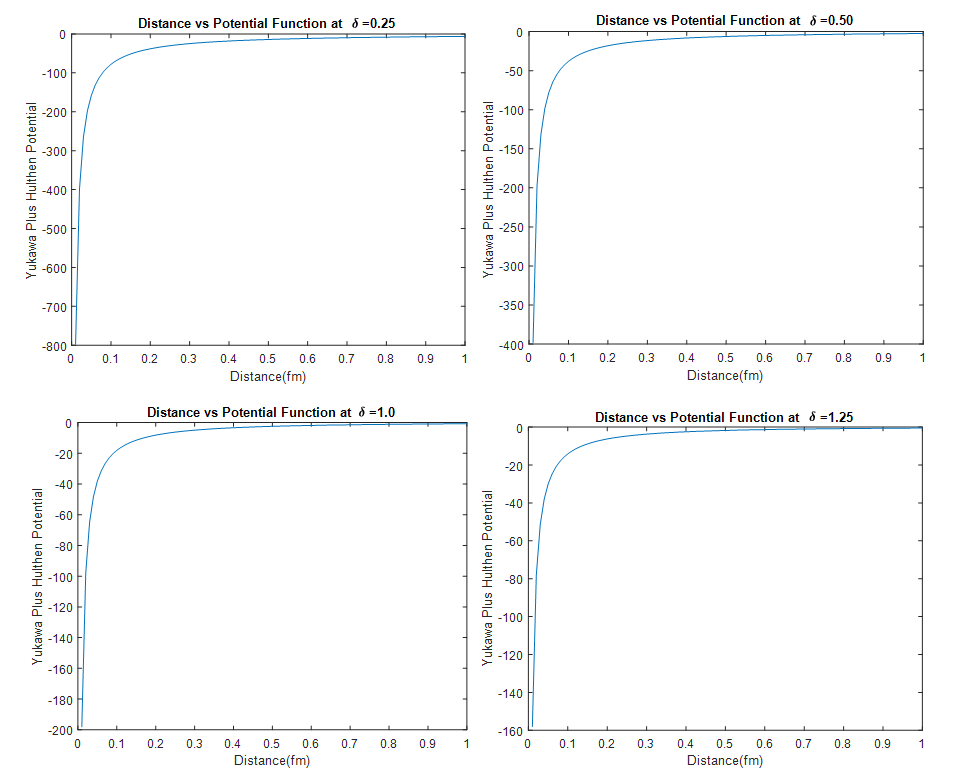 | Figure 2. Strength of Yukawa plus Hulthen Potential with separation of nucleon distance using  approximation approximation |
Moreover, beyond  the strength of potential is uniformly this means that the potential is not working and hence prove both potentials are short-range and their sum is also working only for short ranges. Nature of Yukawa plus Hulthen Potential with centrifugal term approximation based on equation (3) at
the strength of potential is uniformly this means that the potential is not working and hence prove both potentials are short-range and their sum is also working only for short ranges. Nature of Yukawa plus Hulthen Potential with centrifugal term approximation based on equation (3) at  The representation of Yukawa plus Hulthen potential with centrifugal term approximation
The representation of Yukawa plus Hulthen potential with centrifugal term approximation  with distance and screening parameters are shown below. The strength of Yukawa plus Hulthen potential between two nucleons decreases with an increase in the separation distance between them. Moreover also observed that with increasing the screening parameters values the strength of Yukawa plus Hulthen potential decrease. The strength of potential is infinity when two nucleons are closure also at
with distance and screening parameters are shown below. The strength of Yukawa plus Hulthen potential between two nucleons decreases with an increase in the separation distance between them. Moreover also observed that with increasing the screening parameters values the strength of Yukawa plus Hulthen potential decrease. The strength of potential is infinity when two nucleons are closure also at  the potential strength is
the potential strength is  and
and  at screening parameters
at screening parameters 
 and
and  respectively. The strength of potential decrease at 0.02fm drastic while beyond this separation the strength decrease uniformly and become constant. The difference in the strength of potential is due to centrifugal term approximation.
respectively. The strength of potential decrease at 0.02fm drastic while beyond this separation the strength decrease uniformly and become constant. The difference in the strength of potential is due to centrifugal term approximation.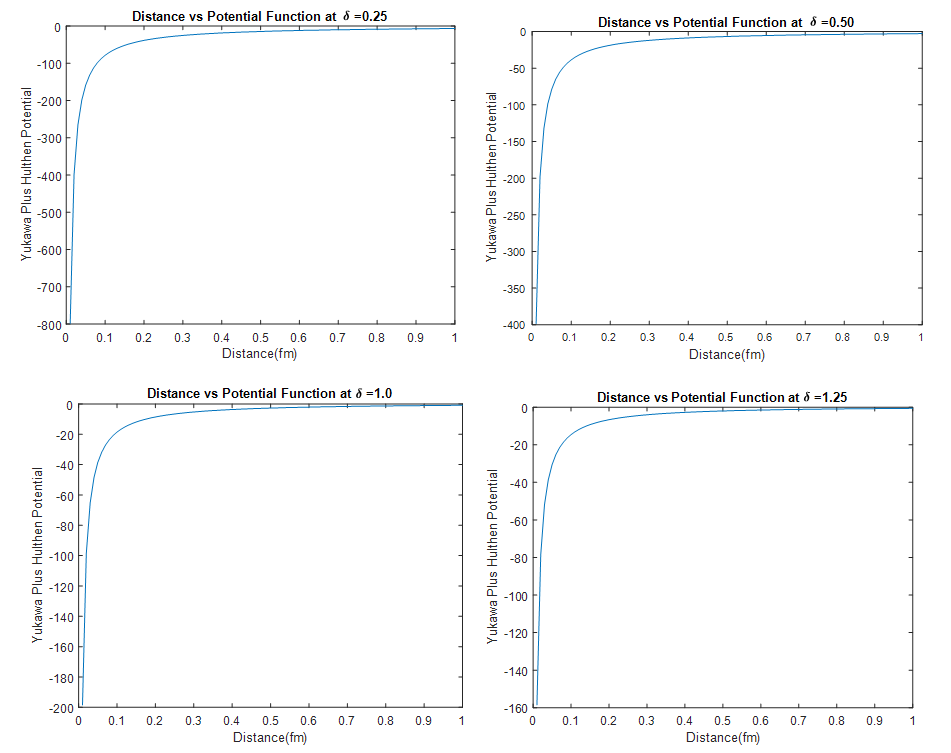 | Figure 3. Strength of Yukawa plus Hulthen Potential with separation of nucleon distance using  approximation approximation |
Comparison of Yukawa plus Hulthen potential with centrifugal term approximationThe strength of Yukawa plus Hulthen potential is based on centrifugal term approximation  and
and  The strength of Yukawa plus Hulthen Potential is different because of these two centrifugal term approximation. The nature for both approximations is the same but the strength is different listed in table 2 and table 3, while the visualization is shown in figure 2 and figure 3. The strength of potential calculated using approximation equation (3) is greater than the strength of potential calculated using approximation equation (2). The difference is very small therefore both approximation can be used to calculate the energy Eigenvalue from any potential.
The strength of Yukawa plus Hulthen Potential is different because of these two centrifugal term approximation. The nature for both approximations is the same but the strength is different listed in table 2 and table 3, while the visualization is shown in figure 2 and figure 3. The strength of potential calculated using approximation equation (3) is greater than the strength of potential calculated using approximation equation (2). The difference is very small therefore both approximation can be used to calculate the energy Eigenvalue from any potential.
4. Conclusions
The strength of Yukawa plus Hulthen potential is observed and study using two centrifugal term approximation equation (2) and equation (3). The strength of potential is found that the strength of potential calculated using equation (3) is greater than equation (2). The linear combination of two potential strength nature is shown in figure 2 and figure 3, and strength of potential and functional value is tabulated in table 1, table 2 and table 3. The nature of function goes decreases with increases in screening parameters and distance separation. The strength of potential is high (infinity) at  and then goes decrease drastic in between 0.01 to
and then goes decrease drastic in between 0.01 to  and beyond t0.02fm strength decrease uniformly and become constant with increasing the separation distance between two nucleons. This show that Yukawa and Hulthen potential is short-range potential and hence Yukawa and Hulthen potential are also short-range.
and beyond t0.02fm strength decrease uniformly and become constant with increasing the separation distance between two nucleons. This show that Yukawa and Hulthen potential is short-range potential and hence Yukawa and Hulthen potential are also short-range.
Declaration Statement
Availability of data and materials: No data are taken from any sources. The data was generated using MATLAB software for this work based on the equation derived above, the plot above is drawn using MATLAB code.Authors Contribution: Equally, contribute this article gives more clear vision.
ACKNOWLEDGEMENTS
We would like to thanks all the members of the Department of Physics, Tri-Chandra Multiple Campus, Kathmandu-44600, Tribhuvan University and Department of physics, Patan Multiple Campus, Lalitpur-44700, Robotic Academy of Nepal, Innovative Ghar Nepal, Lalitpur-44700, and National Research Council Nepal.
References
| [1] | K.J. Oyewumi, and O.J. Oluwadare, The scattering phase shifts of the Hulthen-type potential plus Yukawa potential, The European Physical Journal Plus, 131: 295, 1-9, (2016). |
| [2] | J. A. Olson, and D. A. Micha, Transition operators for atom-atom potentials: the Hilbert-Schmidt expansion, The Journal of Chemical Physics, 68:10, 4352–4356, (1978). |
| [3] | S. Haouat and L. Chetouani, Approximate solutions of Klein-Gordon and Dirac equations in the presence of the Hulthen potential, Physica Scripta, 77:2, 1-5, (2008). |
| [4] | H. Tokmehdashi, A. A. Rajabi, and M. Hamzavi, Hulthén and Coulomb-Like Potentials as a Tensor Interaction within the Relativistic Symmetries of the Manning-Rosen Potential, Advances in High Energy Physics, Volume 2014, 1-14, (2014) http://dx.doi.org/10.1155/2014/870523. |
| [5] | C.O. Edeta and P.O. Okoi, Any l-state solutions of the Schrodinger equation for q-deformed Hulthen plus generalized inverse quadratic Yukawa potential in arbitrary dimensions, Revista Mexicana de F´ısica, 65, 333-344, (2019). |
| [6] | K.J. Oyewumi, and O.J. Oluwadare, The scattering phase shifts of the Hulthén-type potential plus Yukawa potential, Arxiv, 1-12, (2021) https://arxiv.org/ftp/arxiv/papers/1604/1604.03618.pdf. |
| [7] | K. Nozari, and S. Akhshabi, On the Stability of Planetary Circular Orbits in Noncommutative Spaces, 1-5, (2006), https://core.ac.uk/download/pdf/44133712.pdf. |
| [8] | R. Greene and C. Aldrich, Variational wave functions for a screened Coulomb potential, Physical Review A, 14: 6, 2363-2364, (1976). |
| [9] | C. Lam and Y. Varshni, Energies of s eigenstates in a static screened Coulomb potential, Physical Review A, 4: 5, 1875-1876, (1971). |
| [10] | J. P. Edwards, U. Gerber, C. Schubert, M. A. Trejo, and A. Weber, The Yukawa potential: ground state energy and critical screening, Progress of Theoretical and Experimental Physics, Volume 2017:8, 8301-8305, (2017). |
| [11] | A.I. Ahmadov, S.M. Aslanova, M.S. Orujova, S.V. Badalov, S. H. Dong, Approximate bound state solutions of the Klein-Gordon equation with the linear combination of Hulthén and Yukawa potentials, Physics Letters A, Physics Letters A, 383, 3010–3017, (2019). |




 value defines a specific potential like for
value defines a specific potential like for  potential is exponential type, for
potential is exponential type, for  potential is Hulthen potential, for
potential is Hulthen potential, for  potential is Woods-Saxon potential and so on. This generalization is structured by Egrifes et al. in 1999. In tensor form, Hulthen and Coulomb like the potential is defined as
potential is Woods-Saxon potential and so on. This generalization is structured by Egrifes et al. in 1999. In tensor form, Hulthen and Coulomb like the potential is defined as  Here
Here  is potential depth,
is potential depth,  is screening parameter, and 𝑏 is spatial range. In an atomic unit, one can define
is screening parameter, and 𝑏 is spatial range. In an atomic unit, one can define  Equation (1) behaves like the Coulomb potential at
Equation (1) behaves like the Coulomb potential at  and decreases exponentially in case 𝑟≫0. Hulthen potential is widely used for the description of the nucleon-heavy nucleus interactions [2]. For analytical approximate solutions for short ranges potential an approximation for the centrifugal term is used [3] as,
and decreases exponentially in case 𝑟≫0. Hulthen potential is widely used for the description of the nucleon-heavy nucleus interactions [2]. For analytical approximate solutions for short ranges potential an approximation for the centrifugal term is used [3] as,
 . The value of screening parameters used to solve the energy eigenvalue is used in ranges from
. The value of screening parameters used to solve the energy eigenvalue is used in ranges from  to
to  Also, potential depth is selected in this work is selected as
Also, potential depth is selected in this work is selected as  [4] in rages 0 to
[4] in rages 0 to  The wave number-dependent scattering phase shifts
The wave number-dependent scattering phase shifts  for a Hulthén type potential plus Yukawa potential in atomic units
for a Hulthén type potential plus Yukawa potential in atomic units  for 𝑙 = 0 &
for 𝑙 = 0 &  [5,6]. Also, for analytical approximate solutions of short ranges potential an approximation for the centrifugal term is used by different authors (Qiang and Dong, 2007; Dong and Gu, 2008; Jia et al., 2009, Greene and Aldrich, 1976) as,
[5,6]. Also, for analytical approximate solutions of short ranges potential an approximation for the centrifugal term is used by different authors (Qiang and Dong, 2007; Dong and Gu, 2008; Jia et al., 2009, Greene and Aldrich, 1976) as,
 Here k is the strength of the interaction,
Here k is the strength of the interaction,  is a range of the interaction, r is the separation distance between nucleons. In the case of
is a range of the interaction, r is the separation distance between nucleons. In the case of  Yukawa potential tends to Coulomb potential and infinite bound state while in the case of
Yukawa potential tends to Coulomb potential and infinite bound state while in the case of  the Yukawa potential has a finite bound state [8,9,10].
the Yukawa potential has a finite bound state [8,9,10]. and go down exponentially for larger
and go down exponentially for larger  . The linear combination of Hulthén and Yukawa potentials studies in this work. Moreover, some authors are work on energy eigenvalue using the KG equation (Garavelli and Oliveire, 1991; Mathysand and Meyer, 1988; Blokhintesv et al., 2011) [11]. The linear combination of these two potential (Yukawa and Hulthen potential) areas
. The linear combination of Hulthén and Yukawa potentials studies in this work. Moreover, some authors are work on energy eigenvalue using the KG equation (Garavelli and Oliveire, 1991; Mathysand and Meyer, 1988; Blokhintesv et al., 2011) [11]. The linear combination of these two potential (Yukawa and Hulthen potential) areas
 , therefore equation (4) becomes
, therefore equation (4) becomes

 therefore from equation (6), one can write,
therefore from equation (6), one can write, 

 equation (8) becomes,
equation (8) becomes, 
 and
and  and distance between nucleons is taken in between 0 to
and distance between nucleons is taken in between 0 to  At screening
At screening  with increasing the distance the between nucleon functional value decrease and similar nature at other consideration screening parameters are obtained. With increasing the screening parameters the nature of graphs goes shifted from straight lines to curves.This nature is because of the attraction and repulsion in between nucleon with distance and screening parameters. That is when nucleons are very close nucleons goes repulsion and as distance increase nucleons go on attraction, show straight line shifting towards curves. At zero distance functional value is equal for all screening parameters and in 0 to 1fm distance the value take a limit in between 1 to 0.8 for
with increasing the distance the between nucleon functional value decrease and similar nature at other consideration screening parameters are obtained. With increasing the screening parameters the nature of graphs goes shifted from straight lines to curves.This nature is because of the attraction and repulsion in between nucleon with distance and screening parameters. That is when nucleons are very close nucleons goes repulsion and as distance increase nucleons go on attraction, show straight line shifting towards curves. At zero distance functional value is equal for all screening parameters and in 0 to 1fm distance the value take a limit in between 1 to 0.8 for  while for
while for  limit in between 1 to 0.6, for
limit in between 1 to 0.6, for  limit in between 1 to 0.4 and for
limit in between 1 to 0.4 and for  limit in between 1 to 0.3. This show the function value shifted to zero with an increase in the distance between two nucleons. Nature of Yukawa plus Hulthen Potential with centrifugal term approximation based on equation (2) at
limit in between 1 to 0.3. This show the function value shifted to zero with an increase in the distance between two nucleons. Nature of Yukawa plus Hulthen Potential with centrifugal term approximation based on equation (2) at  The representation of Yukawa plus Hulthen potential with centrifugal term approximation
The representation of Yukawa plus Hulthen potential with centrifugal term approximation  with distance and screening parameters are shown below. The strength of Yukawa plus Hulthen potential between two nucleons decreases with an increase in the separation distance between them. Moreover also observed that with increasing the screening parameters values the strength of Yukawa plus Hulthen potential decrease. The strength of potential is infinity when two nucleons are closure also at
with distance and screening parameters are shown below. The strength of Yukawa plus Hulthen potential between two nucleons decreases with an increase in the separation distance between them. Moreover also observed that with increasing the screening parameters values the strength of Yukawa plus Hulthen potential decrease. The strength of potential is infinity when two nucleons are closure also at  the potential strength is
the potential strength is  and
and  at screening parameters
at screening parameters 

 and
and  respectively. The strength of potential decrease at 0.02fm drastic while beyond this separation the strength decrease uniformly.
respectively. The strength of potential decrease at 0.02fm drastic while beyond this separation the strength decrease uniformly. 

 approximation
approximation the strength of potential is uniformly this means that the potential is not working and hence prove both potentials are short-range and their sum is also working only for short ranges. Nature of Yukawa plus Hulthen Potential with centrifugal term approximation based on equation (3) at
the strength of potential is uniformly this means that the potential is not working and hence prove both potentials are short-range and their sum is also working only for short ranges. Nature of Yukawa plus Hulthen Potential with centrifugal term approximation based on equation (3) at  The representation of Yukawa plus Hulthen potential with centrifugal term approximation
The representation of Yukawa plus Hulthen potential with centrifugal term approximation  with distance and screening parameters are shown below. The strength of Yukawa plus Hulthen potential between two nucleons decreases with an increase in the separation distance between them. Moreover also observed that with increasing the screening parameters values the strength of Yukawa plus Hulthen potential decrease. The strength of potential is infinity when two nucleons are closure also at
with distance and screening parameters are shown below. The strength of Yukawa plus Hulthen potential between two nucleons decreases with an increase in the separation distance between them. Moreover also observed that with increasing the screening parameters values the strength of Yukawa plus Hulthen potential decrease. The strength of potential is infinity when two nucleons are closure also at  the potential strength is
the potential strength is  and
and  at screening parameters
at screening parameters 
 and
and  respectively. The strength of potential decrease at 0.02fm drastic while beyond this separation the strength decrease uniformly and become constant. The difference in the strength of potential is due to centrifugal term approximation.
respectively. The strength of potential decrease at 0.02fm drastic while beyond this separation the strength decrease uniformly and become constant. The difference in the strength of potential is due to centrifugal term approximation.
 approximation
approximation and
and  The strength of Yukawa plus Hulthen Potential is different because of these two centrifugal term approximation. The nature for both approximations is the same but the strength is different listed in table 2 and table 3, while the visualization is shown in figure 2 and figure 3. The strength of potential calculated using approximation equation (3) is greater than the strength of potential calculated using approximation equation (2). The difference is very small therefore both approximation can be used to calculate the energy Eigenvalue from any potential.
The strength of Yukawa plus Hulthen Potential is different because of these two centrifugal term approximation. The nature for both approximations is the same but the strength is different listed in table 2 and table 3, while the visualization is shown in figure 2 and figure 3. The strength of potential calculated using approximation equation (3) is greater than the strength of potential calculated using approximation equation (2). The difference is very small therefore both approximation can be used to calculate the energy Eigenvalue from any potential. and then goes decrease drastic in between 0.01 to
and then goes decrease drastic in between 0.01 to  and beyond t0.02fm strength decrease uniformly and become constant with increasing the separation distance between two nucleons. This show that Yukawa and Hulthen potential is short-range potential and hence Yukawa and Hulthen potential are also short-range.
and beyond t0.02fm strength decrease uniformly and become constant with increasing the separation distance between two nucleons. This show that Yukawa and Hulthen potential is short-range potential and hence Yukawa and Hulthen potential are also short-range.  Abstract
Abstract Reference
Reference Full-Text PDF
Full-Text PDF Full-text HTML
Full-text HTML

